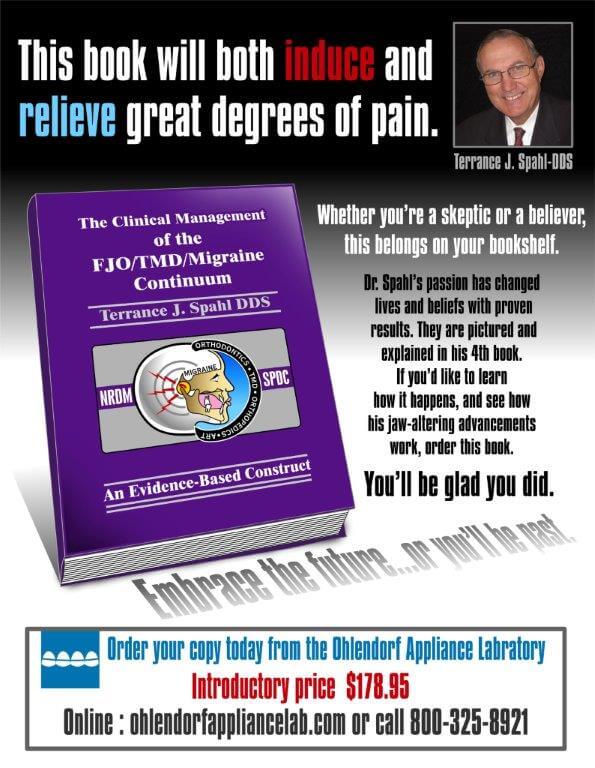What is “TMJ” or “TMD”?
The term “TMJ” is dental slang for a serious and painful degenerative jaw joint condition that goes by many names:
TMJ syndrome, temporomandibular joint syndrome, temporomandiublar joint pain – dysfunction syndrome, temporomandibular disorder (TMD), Costen’s syndrome, etc. It is not a disease but rather a condition. The initials stand for “temporomandibular joint”, the anatomical name for the jaw joint back by the ear where the lower jaw attaches to the base of the skull.
What is it like to have it?
Patients, including children, adolescents and adults, suffering from TMJ pain-dysfunction syndrome, or plain old “TMJ”, as it is often called (by us older clinicians), exhibit jaw joint “clicking” during chewing, sore jaw joints, sore jaw muscles, limited opening of the mouth, clenching or grinding of the teeth, especially during sleeping, neckaches, earaches, tooth pain with no dental cause, ringing in the ears or a stuffy feeling in the ears, and many other unpleasant symptoms. But the BIG thing most all TMJ patients suffer from is chronic recurrent headaches. They can be headaches of any variety, intensity, location, duration, or frequency, from once a month to daily, and the big finding of modern times is that the worst of these headaches, the migraine (regardless of what you have heard or read elsewhere) is the end stage the long degenerative pathway of this condition! Even children can have true “TMJ” troubles ranging from mild TMJ problems that can result in one headache every couple of months all the way to TMJ problems of such an advanced nature that they will suffer from severe migraines even in spite of their youth. The latest finding is that even some forms of Tourettes Syndrome are caused by “TMJ”.
How is it treated?
True TMJ problems are treated one of three ways. First, you can treat the symptoms i.e. the effects. That means taking various combinations of medicines, pills, or shots in conjunction with a variety of other pain relieving and/or relaxation treatments. But that only hides it. Secondly, you can treat the cause, i.e. get at the source, and heal the damaged temporomandibular joint itself that causes it all. Thirdly, you can use both methods 1) and 2) at the same time.
How do you heal damaged jaw joints?
First of all, the name “temporomandibular joint” is a compound word. It is a name that is composed of two other names. The name for the bone on the side of the head that has the ear hole in it and the socket for the lower jaw to fit into in Latin is “os temporalis.” In Latin, the word “temporal” means time – as in your “temples,” where the first grey hairs appear! The Latin word for the lower movable jaw is “os mandibularis” or mandible. Hence, the jaw joint back by the ear where the lower jaw (which is a one piece horseshoe shaped affair) attaches to the skull is call the “temporomandibular joint” – a big name for a relatively small thing – but a very important thing where chronic recurrent headaches are concerned. Healing seriously damaged temporomandibular joints (TMJs) and relieving the serious headache, neckache, and jaw muscle pain problems associated with it (regardless of what you’ve read or heard elsewhere) consists of a very basic and simple procedure. It involves realigning the bite of a lower jaw that is trapped too far back during chewing by its own upper jaw, (malocclusion). A bite that is back too far drives the lower jaw too hard into the back of its own socket (where all those nerves and arteries course through). Correcting this with proper treatments delivers that offending lower jaw a bit more forward just enough and holding it forward just enough permanently so that, during biting, the back ends of the lower jaw (condyles) are no longer jammed into their own sockets. This then stops the repetitive compressing and injury to those same nerves and arteries by the lower jaw at full biting force. – And doing that means European-style, removable, FUNCTIONAL APPLIANCES!!! (See the orthodontic –TMJ connection?). There are many kinds of TMJ-damaging bad bites and many ways of doing this. But in a nutshell, that’s it. Biting back too hard causes the problem. Realigning the bite more forward quickly cures the problem. All the rest is merely a matter of details. It’s just that sometimes those “details” can get quite complicated!

